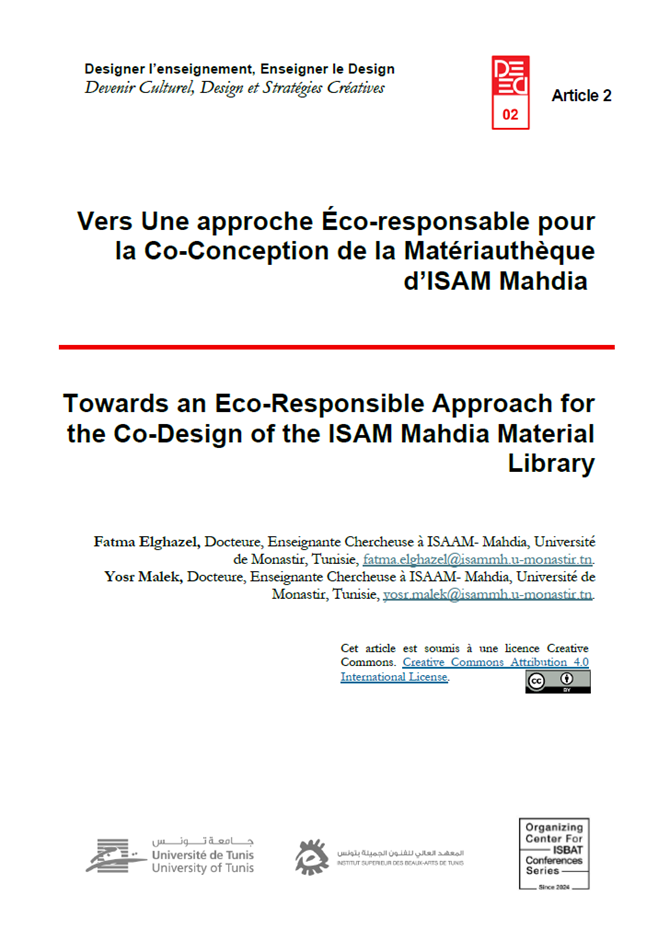Abstract
The eco-responsible approach in design has become a growing concern today, aiming to minimize human impact on the environment. In this regard, it is essential to teach this design approach to students to train future designers who are aware of environmental and socio-cultural challenges. Our article falls within the framework of a research-creation project. We present the experience of an educational workshop in which second-year undergraduate students in Image and Space Design participated in the co-design of the ISAM Mahdia Material Library using an eco-responsible approach. The challenge is to show them how the constraints of this approach can, on the contrary, become a source of innovation rather than limit their creative freedom. It is worth noting that a material library serves as a space for innovation, offering students direct access to a wide range of materials that stimulate their creativity and enhance their understanding of physical and aesthetic properties. This is aimed at supporting the design of innovative products, spaces, and cultural experiences. This article aims to evaluate the contribution of students to the co-design of a sustainable materials library by analyzing how the resulting eco-graphic and eco-spatial identity fits into a life cycle that considers both environmental issues and the improvement of the user experience.
References
Abrassart, C., & Aggeri, F. (2002). La naissance de l’éco-conception. Responsabilité et environnement, Annales des mines 25, 14-63. https://annales.org/edit/re/2002/re25/abresart41-63.pdf
Alahira, J.& al. (2024). Pratiques de conception graphique éco-innovantes : exploiter les beaux-arts pour améliorer la durabilité dans la conception industrielle. Revue des sciences et technologies de l'ingénierie, 5(3):783-793. DOI : 10.51594/estj.v5i3.902
Alfuraty, A. B. (2020). Sustainable Environment in Interior Design: Design by Choosing Sustainable Materials. IOP Conference Series: Materials Science and Engineering, 881(1), 012035. DOI : 10.1088/1757-899X/881/1/012035
Basque, J. (2015). Un modèle méthodologique de recherche-design (Design-Based Research) pour favoriser l'innovation pédagogique en enseignement supérieur. Colloque Cirt. Université de Sherbrooke. https://r-libre.teluq.ca/737/
Bridgstock, R., & Carr, L. (2013). Creative entrepreneurship education for graduate employability in the creative arts. Tasmanian College of the Arts, University of Tasmania and Creative Arts Learning and Teaching Networ. https://eprints.qut.edu.au/62752/
Canal-Marques, A., & Palmitessa, G. F. (2023). Structure of a material library within an academic FabLab oriented by Design. https://doi.org/10.29183/2596-237x.ensus2023.v11.n4.p137-149
Daubier, M., et Daubier, S. (2022). Outil 52. Le Workshop. Pro en Agilité : 66 outils 10 plans d'action 12 ressources numériques (p. 154-155). Vuibert. https://shs.cairn.info/pro-en-agilite--9782311625462-page-154?lang=fr.
Fukushima, T. (2002). Integrated environment-conscious life-cycle design (eco-life-cycle design) of building structural composite materials, components, and/or systems: as a basis of establishment of sustainable eco-buildings and eco-cities. Materials Transactions, 43(3), 368-377. https://doi.org/10.2320/matertrans.43.368
Gamaliia, K., Turchak-Lazurenko, L., Lavrenyuk, O., Penchuk, O., & Lytvynenko, N. (2024). Synergy of design, culture, and innovation in pedagogy: New horizons for education. Research Journal in Advanced Humanities. https://doi.org/10.58256/rjah.v4i4.1131.
Jha, B. (2016). Institutional resource centres and design education. Library Review, 65, 625–632. https://doi.org/10.1108/LR-11-2015-0110
Jubert, R. (2019). La communication visuelle et graphique à l’aune des défis environnementaux : des priorités à redéfinir. Sciences du Design, 10(2), 68-75. https://doi.org/10.3917/sdd.010.0068.
Kadas, S. (2018). Exploring the Meaning of Sustainability within Three Selected Institutions of the Graphic Design Field: A Phenomenological Study [Thése de doctorat, West Virginia University ].https://researchrepository.wvu.edu/cgi/viewcontent.cgi?article=8237&context=etd
Leousis, K. (2015). Creating an Interdisciplinary Materials Lab in the Design Library. Art Documentation: Journal of the Art Libraries Society of North America, 34(1), 124–136. https://doi.org/10.1086/680569
Mol, A., & Stutz, D. (2023). Planning of the Institute of Arts and Design’s material library: proposition of guidelines and structuring of sample cataloging. https://doi.org/10.29183/2596-237x.ensus2023.v11.n2.p81-93
Moya,T. A., A. van den Dobbelsteen, M. Ottelé, and P. M. Bluyssen (2019).A review of green systems within the indoor environment. Indoor and Built Environment, vol. 28, no. 3, pp. 298–309, Mar. 2019. DOI: 10.1177/1420326X18783042.
Office québécois de la langue française. (2002). Grand dictionnaire terminologique. Gouvernement du Québec.
Quero, L. (2023). L’écoconception pour les graphistes. Pyramid, 2023.
Rinn, L. (2024). Esthétique Durable, [Mémoire de bachelor théorique, Haute École d'Art et de Design de Genève].https://folia.unifr.ch/global/documents/328903
Roy, R. (2009). Designing for sustainability. Oxford University Press. http://oro.open.ac.uk/19104/
Sharma, A. (2010). Contemporary Practice In Sustainable Design:Appraisal And Articulation Of Emerging Trend. Applied Reconfigurable Computing, 128, 119–129. https://doi.org/10.2495/ARC100111
Thabuis, Y. (2024, février 12). Le Guide Complet de l’Éco-Branding : Réinventer le Design Graphique pour un Avenir Durable. https://printixel.com/le-guide-complet-de-leco-branding-reinventer-le-design-graphique-pour-un-avenir-durable/
Vallero, D. A., Braiser, C., Şahali, Ö., Hammer, K., & Tilt, B. (2008). Sustainable Design: The Science of Sustainability and Green Engineering. https://www.amazon.com/Sustainable-Design-Science-Sustainability-Engineering/dp/0470130628
Zahedi, M., & Tessier, V. (2023). Le modèle de la théorie de l’activité pour le design : un outil à explorer pour la recherche-projet. ModACT. https://doi.org/10.25518/modact2023.57

This work is licensed under a Creative Commons Attribution 4.0 International License.
Copyright (c) 2025 Dr. Fatma Elghazel, Dr. Yosr Malek


